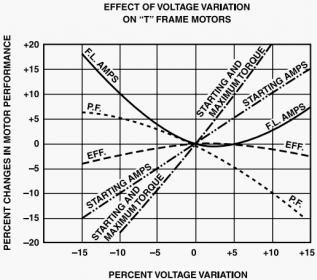A larger conductor can lead to higher starting current also, there is pro's as well as con's to this. Reduced voltage is a starting method often used to limit the surge on a line when starting large motors and a some reduction of voltage for smaller motors doesn't hurt either - it is kind of a crude "soft starter" to some extent.
Lower then rated voltage or voltage drop is not a good thing for most single phase AC motors (Asynchronous), voltage drop increases slip which cause the motor to take longer to reach full sync speed as well as raise the FLA, the more a motor slips the higher the current it will pull and the more heat damage it will cause to the windings, sure a larger conductor will allow a higher starting current, but it will be the design starting current and the motor will reach full speed much faster which will not produce as much winding heat, running a motor up to 5% over its design voltage can even reduce the time the motor takes to reach full speed thus reducing the amount of heat developed while starting, torque is also increased as well as the motor will have less slip, keep in mind that a motor starting up with the full rated voltage will never pull more then it's designed LRA or start up amps.
Take a look at this chart:

Notice that starting torque is +10% at 5% over voltage, while starting amps stayed proportional to the over voltage, this means that the motor will reach full running speed allot faster which doesn't allow time for the windings to heat, FLA and EFF remain normal, but with a 5% VD you have the direct opposite, you have reduced starting torque to -10% EFF has dropped while FLA has increased for the same given load, so the motor now takes longer to reach full run speed (longer time at LRA), has more slip and runs hotter as well as produces more heat in the windings.
The only time a lower voltage is good for a motor is when the motor is over sized for the load, a motor that is loaded 75% can gain a little EFF back by reducing the voltage 5%
High torque applications such as air compressors, and HVAC compressors can actually run better and last longer with a 5% over voltage, while a constant torque applications such as pumps and fans or blowers can have a slight negative effect and be better with rated voltage to no more then 2% over voltage.
Reduced voltage starting is done on 3 phase 12 lead motors and is a whole different animal then a single phase HVAC compressor, very rarely are these reduced voltage set ups started under a load, and never used on a single phase motor without controlling the frequency/voltage/current, do that to an air compressor and the motor would most likely stall.
Of course the above doesn't apply to universal (AC/DC) motors found in most hand tools, as these motors are voltage speed controlled but also loose allot of torque so can be stalled much easier at a reduced voltage which can be damaging.


